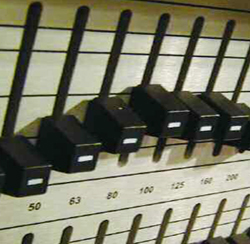
A Little EQ Insight
Not only are a graphic filters spaced at third octave intervals, they’re generally a third of an octave wide, meaning their 3 dB down points are at the next filter’s center frequency.
This means the combined response of two filters on either side of an unused filter’s frequency combine to work on that frequency as well.
An old rule of thumb with graphic EQs is that if you’ve used more than half of their sliders, you have “over equalized.”
It’s considered good practice when this happens to simply flatten out the graphic EQ and start over.
If you’ve ever watched old sound guys who are comfortable using a graphic EQ, it’s quite normal to see them pull a frequency and then put back some gain from the adjacent filters to sharpen the response of the frequency they’re trying to remove.
If you’ve ever felt like you were struggling with the graphs in a monitor rig at low levels of cut, you probably were using a graph with “proportional Q.”
Old school models of graphic equalizers have proportional Q or “variable Q” filters, meaning that they’re sharper at extreme amounts of boost or cut, but at lower gain, the shape of the filter is broad. The result is that small amounts of adjacent boost combine to provide an overall gain that is greater than indicated by the physical controls on the front panel because of the filters’ overlap.
More Recent Pioneering
In the 1880s, Rane Corp. pioneered the development of “constant Q” or “constant bandwidth” filters for graphic equalizers, which maintain the same narrow Q or bandwidth at low boost or cut as they have at high gain, making them better suited for treating room modes or for feedback control.
These days many brands of graphic equalizers provide constant Q filters, including Ashly, Carvin, dbx and XTA.
In the 1990s BSS introduced the FCS-960 Dual Mode graphic equalizer which provided constant Q filters with the ability to sharpen their response by engaging a single switch. In the “normal” mode, the 960’s filters provide smooth summation from one filter to the next, even at large amounts of boost or cut, better for use as tone controls for sweetening.
In the “fine” mode, its filters are sharpened to more precisely cut or boost frequencies within the intended third octave range, earning them favor among engineers over other graphic equalizers for notching room modes and for feedback control.
